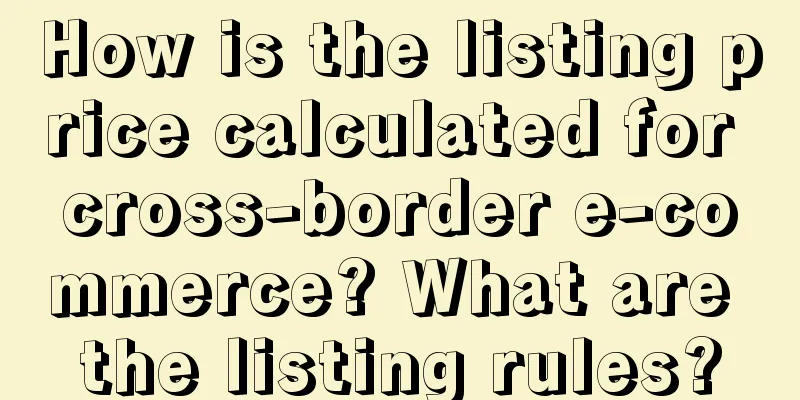How is the listing price calculated for cross-border e-commerce? What are the listing rules?

|
In recent years, cross-border e-commerce platforms have become very popular. As people's consumption level gets higher and higher, people also pay more attention to the quality and brand of goods. Therefore, when it is inevitable to buy branded goods from other countries, how to calculate the price of cross-border e-commerce listings? 1. How to calculate the listing price of cross-border e-commerce? Using costs to set prices is the most common method. It is simple and crude. You only need to know the purchase price or production cost of your product, the weight of the product and the courier quotation to calculate the freight, and then calculate some platform fees, such as listing fees, transaction fees, withdrawal fees, etc. In addition, sellers using overseas warehouses may also need to calculate the first-leg, warehousing, and last-leg fees, etc. Then simply use the total costs you calculated, combined with the exchange rate, plus your profit. You can take a specific number or a percentage of the profit, and the result is your selling price. Another thing you need to consider is the popularity of the style. If a large number of new styles are launched, try to sell the old ones. 2. What are the listing rules? Amazon’s Code of Conduct for Sellers clearly states: “It is prohibited to create duplicate ASINs (i.e., create new ASINs for products that already exist in the catalog), otherwise your ASIN creation or sales permissions may be suspended or permanently revoked. ASIN duplicate listings include: 1. Refurbish and re-upload the existing ASIN. 2. Fusion, merge listings at will. 3. The same product is uploaded using different UPCs on different sites. 4. The UPC source is not genuine, and other sellers have also uploaded products using the same UPC. 5. After brand registration, UPC exemption has been applied, but products are still uploaded using UPC or other key attributes that are not in brand registration. Abuse variants include: 1. Adding child products that are not true variations of the parent product. This includes adding incorrect variations to ASINs that have already been created. 2. Changing the product details page of the parent product so that it does not match the child product. 3. Different style product group variations in the same category. For example, if you create different style sub-variants for a T-shirt, it will be removed from the shelves. 4. Use a table to manually add attributes that did not originally exist as variant attributes. 5. Merge zombie listings to get reviews. 6. Put the new product line into the old variation group. Some sellers will put the new upgraded product into the variation group of the old product in the form of a sub-body. The purpose is also to take advantage of the ranking and reviews that have been obtained. The above is the calculation method for the listing price of cross-border e-commerce. Now no matter which platform you are on, when doing cross-border e-commerce, merchants must abide by the rules. The requirements of cross-border e-commerce will be more stringent, so all merchants must abide by them. |
<<: What are the seven major scams in cross-border e-commerce? How to prevent them?
>>: How to open a store on Shopee without a business license? What qualifications are required?
Recommend
From local life to food delivery, has Douyin added another "leg"?
In the food delivery business, Douyin has chosen t...
2023, 10 predictions for the video account ecosystem
The collision between the video account and the We...
Breaking the dimensional wall, "Barbie" becomes the new traffic code
Barbie will conduct joint marketing and promotion ...
Brand value innovation starting from users
The charm of a brand comes from not blindly follow...
Does the new Amazon store make money? How to operate it?
There are many domestic seller friends who want to...
The road to a higher salary: Eight essential skills for senior data analysts
This article summarizes the eight abilities that a...
Where can I see Amazon Post? What are the benefits?
There are many functions and services on the Amazo...
How long does it take to return products on Amazon in the United States? How to reduce the return rate?
After shopping on the Amazon platform, if you are ...
Overcoming the "male" barrier, Xiaohongshu's content boundaries are becoming more generalized
This article first points out that the number of m...
Skits invade the plot number
The short drama craze swept through 2024, and the ...
With 100 million members and member contributions accounting for over 40%, how does the “latecomer” Burger King develop its private domain?
Burger King, which entered the Chinese market late...
What kind of goods are better to sell in cross-border e-commerce? How to choose the main category?
Cross-border e-commerce has become a global busine...
How to open an independent cross-border e-commerce website? How to promote an independent website?
With the continuous acceleration of the process of...
These three brands told me: Don’t compare yourself to others, it’s just a collaboration | Anti-anxiety special
In this age of social media, we are always tempted...
Xiaohongshu anchor business tips: Sell emotions and sell goods at the same time
Everyone is promoting products, so instead of watc...









